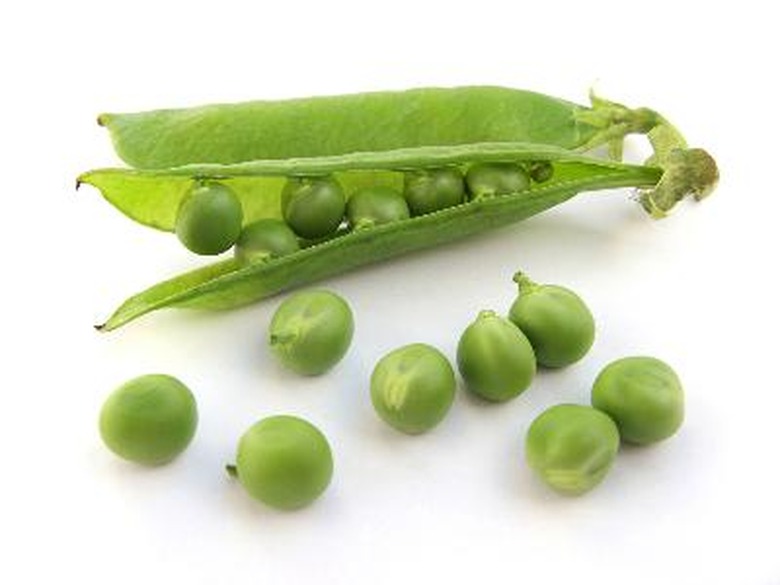The Effect Of Temperature On Pea Respiration
What effect does temperature have on cellular respiration in plants like peas? Respiration is the process that burns the sugars produced by plants in photosynthesis; in some ways, respiration is the opposite process of photosynthesis. While plants use energy from the sun during photosynthesis to combine water and carbon dioxide to make glucose and oxygen, during respiration, they combine glucose and oxygen to produce carbon dioxide, water and energy to fuel their cells. Temperature is one of the main variables that affects the rate of respiration in plant species, including peas.
How Plant Respiration Works
How Plant Respiration Works
Similar to how animals breathe all day and all night while they are alive, plant respiration occurs nonstop. While most plants photosynthesize only during daylight hours, they respire 24 hours a day.
Like most natural processes, respiration is affected by several variables. While the rate of photosynthesis in plants is limited by the supply of water, carbon dioxide and sunlight, the primary limiting factors for plant respiration are glucose and oxygen.
Keep in mind, though, that photosynthesis and respiration work together in plants, and while their chemical equations are opposite, a healthy balance of both processes is needed to keep a plant healthy. Greenhouse growers pay close attention to the relationship between photosynthesis and respiration in their plants to produce strong and abundant crops.
How Does Temperature Affect Respiration?
How Does Temperature Affect Respiration?
In general, higher temperatures result in higher rates of respiration in plants like peas. There is a wide range of optimum temperatures for plant respiration, which depends on plant species. A rough estimate for the optimum temperature for respiration is 65 to 105 degrees Fahrenheit.
Temperatures below freezing (zero degrees Celsius, 32 degrees Fahrenheit) or over about 120 degrees Fahrenheit will cause plant cells to break down, which will bring both photosynthesis and respiration to a halt.
In a study of corn yield, researchers found that respiration rates increased rapidly as temperatures increased. For every 13 degree–Fahrenheit increase in the temperature in this study, the rate of respiration in the corn plants nearly doubled.
Other Factors Affecting Plant Respiration
Other Factors Affecting Plant Respiration
Because respiration metabolizes the sugars produced by photosynthesis, respiration is impacted by the limiting factors of this essential process. In other words, respiration is dependent on photosynthesis, as the process of respiration uses the glucose made during photosynthesis to make energy.
The limiting factors of photosynthesis are carbon dioxide, water and sunlight, so these factors impact respiration too. Too much or too little of any of these inputs can reduce rates of both photosynthesis and respiration. These processes are interconnected, and the variables that affect them interact to impact plant growth.
For instance, although the rate of respiration in plants increases with temperature increases, this can also cause an increased rate of transpiration. Transpiration is the process through which plants lose water through their leaves. Too much transpiration can lead to too little water, which may reduce the rate of photosynthesis. When photosynthesis slows down, this can decrease the amount of sugars available for respiration.
Relationship Between Photosynthesis and Respiration
Relationship Between Photosynthesis and Respiration
So, when it comes to plant respiration, temperature is one of many factors that can impact the rate at which sugars are burned. Levels of oxygen and glucose also affect rates of respiration, and when the balance between photosynthesis and respiration is off, plants often grow with reduced vigor.
Knowing this, commercial plant growers seek the ideal conditions to increase photosynthesis and decrease respiration in controlled conditions in order to produce strong, healthy plants. One strategy for accomplishing this is to reduce the temperature inside greenhouses at night. This helps limit the rate of respiration, as respiration decreases with lower temperatures. Since plants respire 24 hours a day but photosynthesize only during the day, decreasing the rate of respiration at night helps plants conserve the sugars they produce when the sun is shining.
Cite This Article
MLA
Sloane, Christina. "The Effect Of Temperature On Pea Respiration" sciencing.com, https://www.sciencing.com/the-effect-of-temperature-on-pea-respiration-12272978/. 1 December 2021.
APA
Sloane, Christina. (2021, December 1). The Effect Of Temperature On Pea Respiration. sciencing.com. Retrieved from https://www.sciencing.com/the-effect-of-temperature-on-pea-respiration-12272978/
Chicago
Sloane, Christina. The Effect Of Temperature On Pea Respiration last modified March 24, 2022. https://www.sciencing.com/the-effect-of-temperature-on-pea-respiration-12272978/
